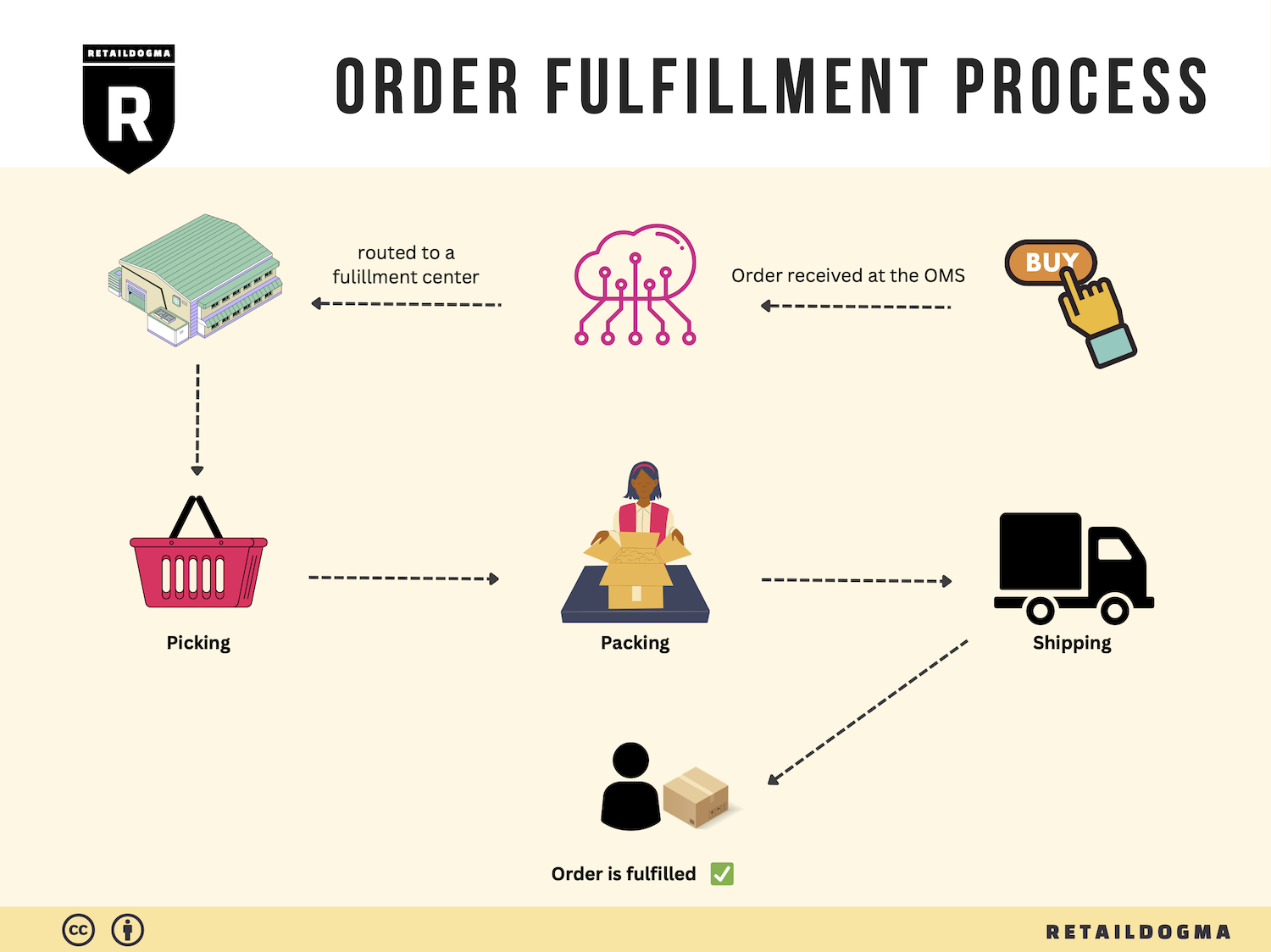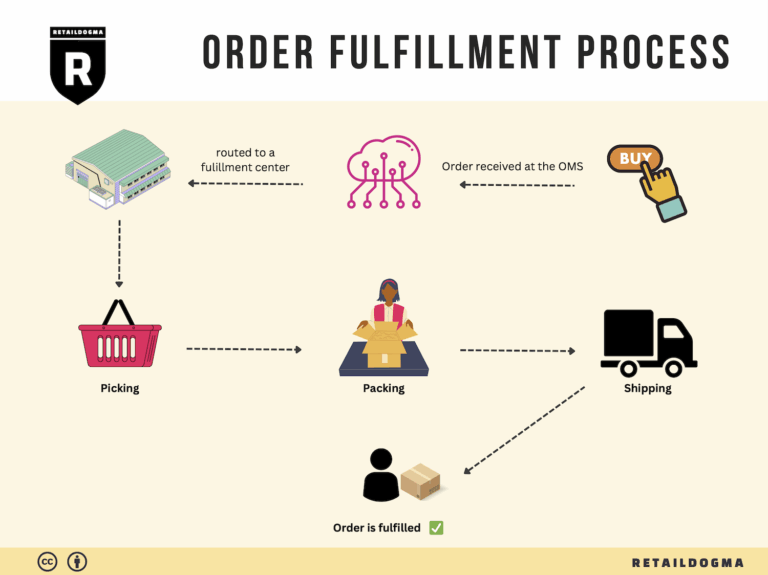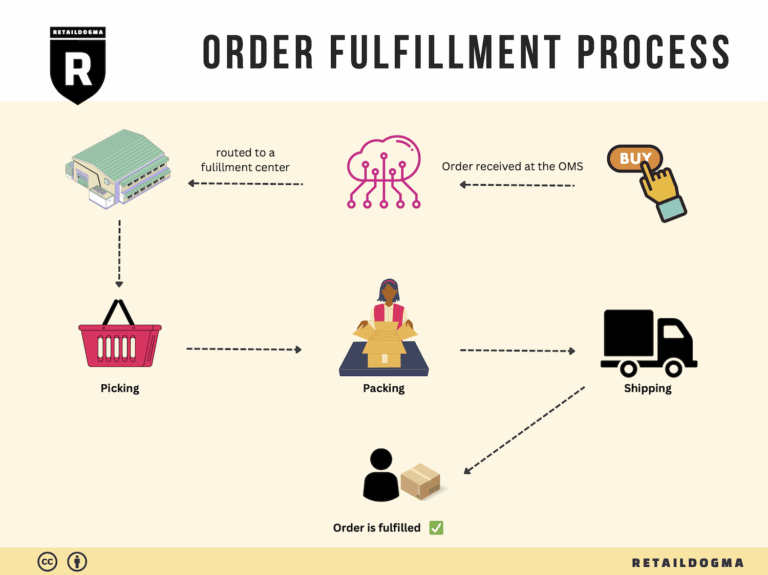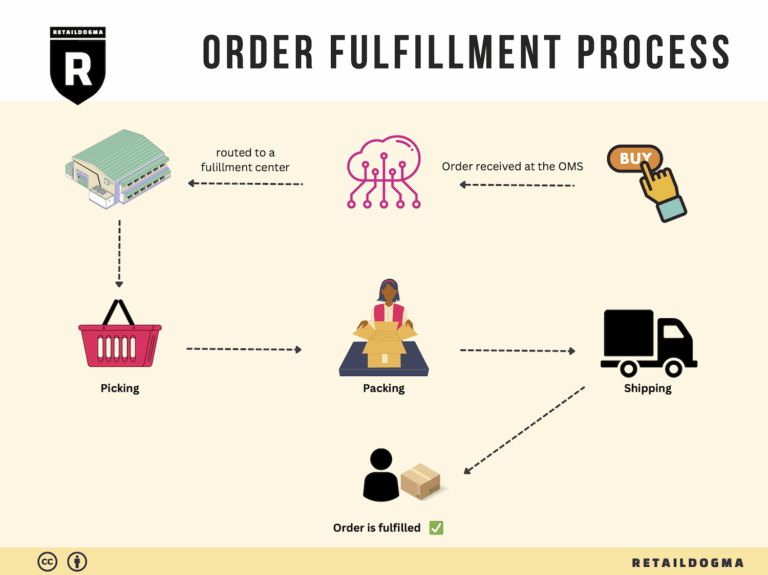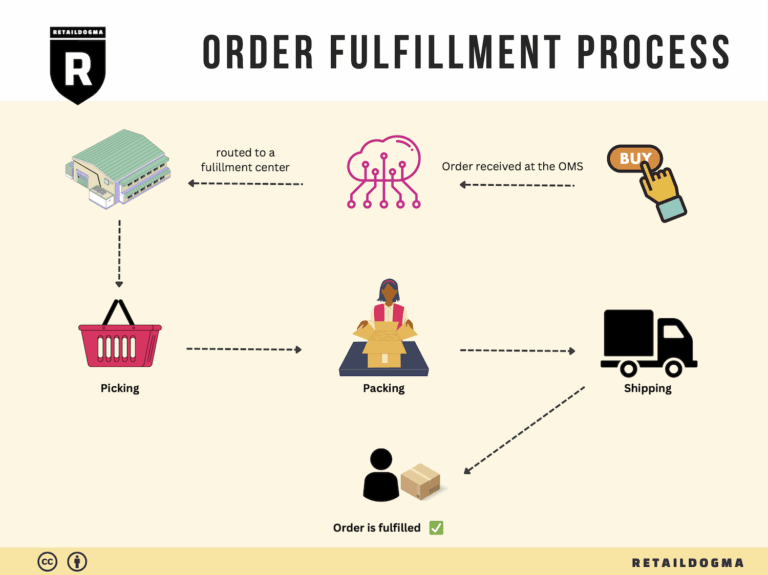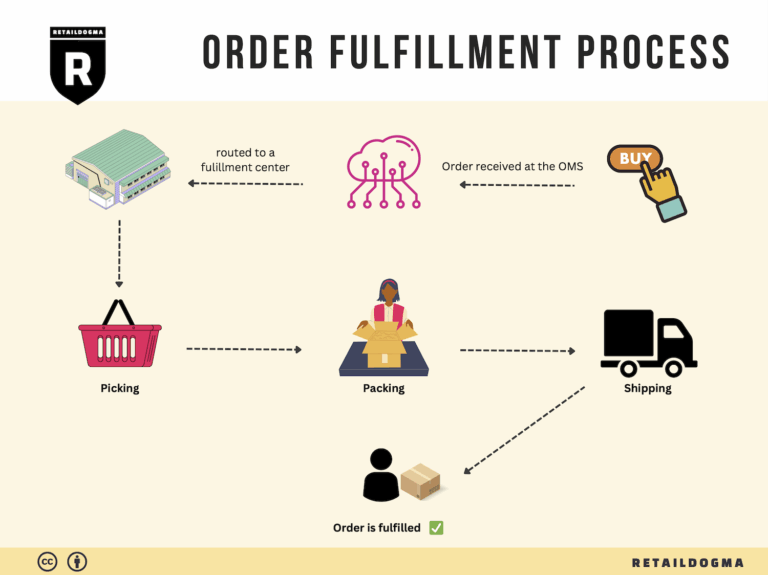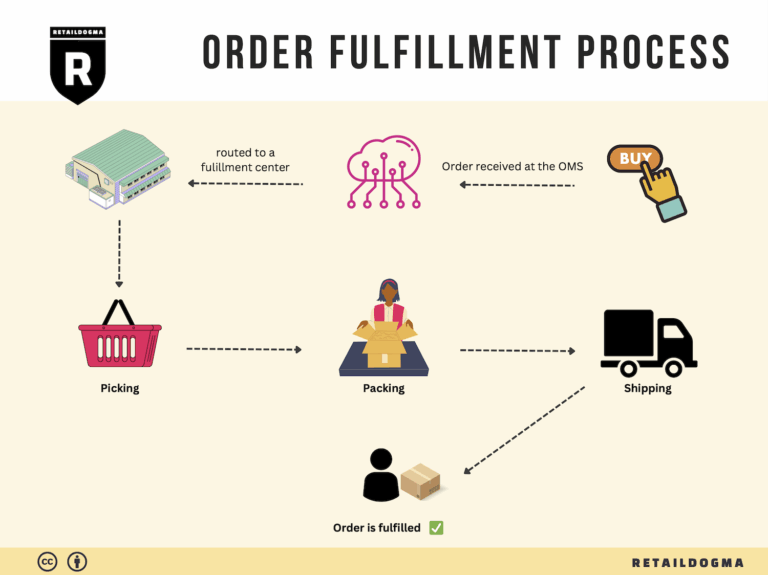How Order Fulfillment Works: A Step-by-Step Guide for Businesses
What is E-commerce Fulfillment? An Introduction for Growing Businesses
Understanding the Challenges of E-commerce Fulfillment
As an e-commerce business owner or operations manager, you may have experienced the overwhelming nature of packing and shipping orders. The excitement of growing sales can quickly turn into stress when faced with the complexities of logistics, inventory management, and customer expectations for fast delivery. This is where the concept of fulfillment becomes crucial. Simply put, fulfillment is the process of getting a product from your warehouse or storage to your customer’s doorstep. It encompasses everything from inventory storage and order processing to packing and shipping.
The Importance of Effective Fulfillment Solutions
For growing businesses, choosing the right fulfillment strategy can significantly impact customer satisfaction and operational efficiency. As your order volume increases, so does the need for a streamlined process that can handle the demands of your expanding customer base. This guide aims to demystify the world of e-commerce fulfillment by covering essential topics that will help you navigate your options effectively.
What This Guide Will Cover
-
Fulfillment Models: We will explore various fulfillment models, including Third-Party Logistics (3PL) and Fulfillment by Amazon (FBA), highlighting their pros and cons. Understanding these models will empower you to select the one that aligns best with your business goals and customer needs.
-
Core Services: We will outline the core services offered by fulfillment providers, such as inventory management, order processing, packing, shipping, and returns handling. Knowing what services are available will help you identify the features that matter most for your operations.
-
Choosing a Fulfillment Partner: Selecting the right fulfillment partner is critical for scaling your business. This section will provide practical tips on what to look for in a partner, including technology integration, location advantages, and customer service capabilities.
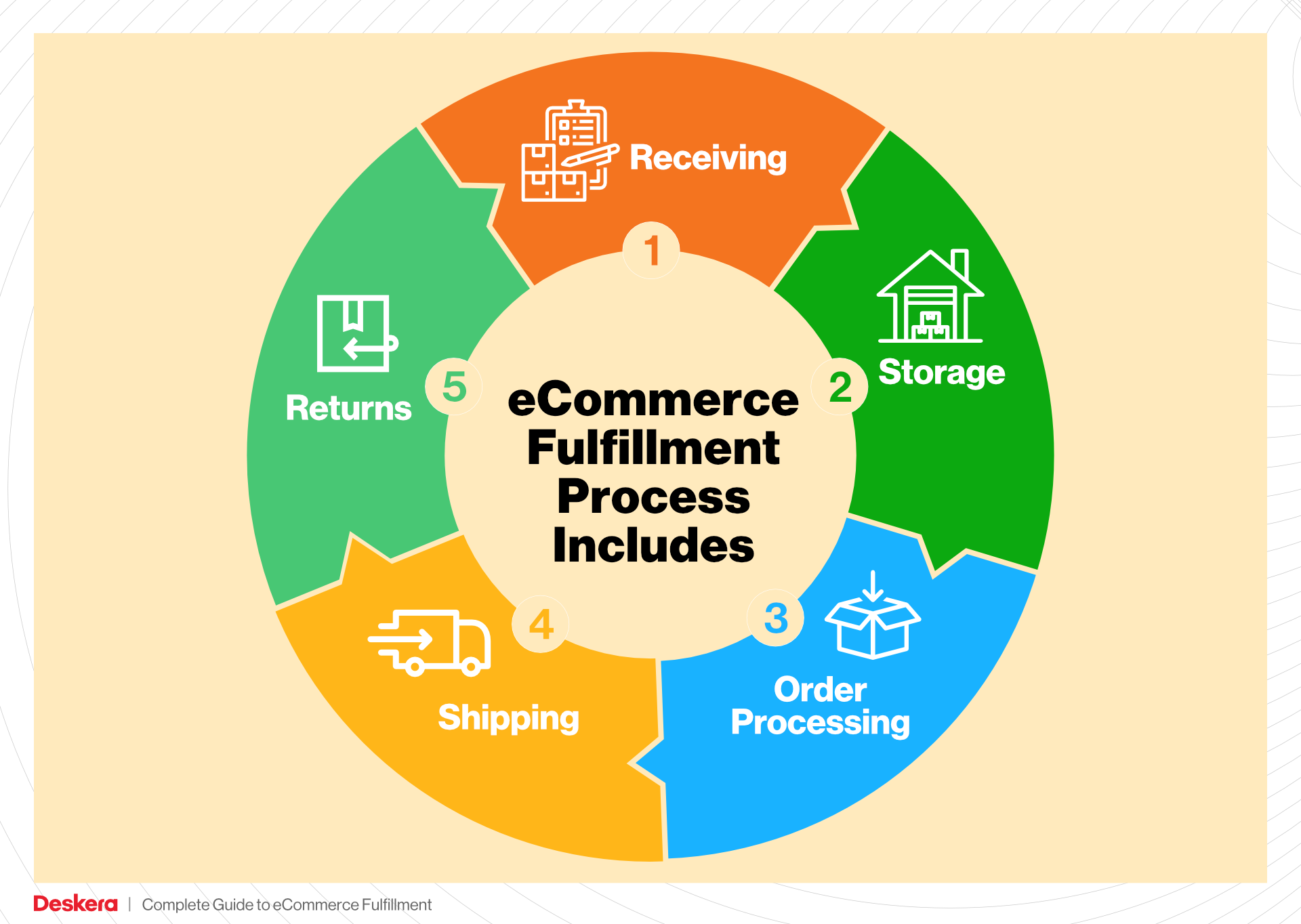
-
Pricing Considerations: Understanding the pricing structures of fulfillment services is essential for budgeting and profitability. We will break down common pricing models and what factors can influence costs, helping you make informed financial decisions.
Empowering Smart Logistics Decisions
The ultimate goal of this guide is to empower your business to make smart decisions about logistics and fulfillment. With the right knowledge, you can optimize your operations, enhance customer satisfaction, and focus on what you do best—growing your business. Whether you’re just starting or looking to scale, understanding fulfillment is a vital step in your e-commerce journey.
What You’ll Learn In This Guide
- What is E-commerce Fulfillment? An Introduction for Growing Businesses
- The Order Fulfillment Process: From ‘Buy’ Button to Customer’s Door
- Comparing Fulfillment Models: In-House vs. 3PL vs. Dropshipping
- A Deep Dive into Amazon FBA: Pros, Cons, and Who It’s For
- Core Services Offered by Fulfillment Centers
- How to Choose a Fulfillment Partner: A 6-Point Checklist
- Understanding Fulfillment Pricing: A Breakdown of Common Fees
- Frequently Asked Questions (FAQs) about Fulfillment
- Conclusion: Is Outsourcing Fulfillment the Right Move for Your Business?
- Important Disclaimer
The Order Fulfillment Process: From ‘Buy’ Button to Customer’s Door
1. Receiving Inventory
The first step in the order fulfillment process is receiving inventory. This involves accepting goods from suppliers and verifying their accuracy against purchase orders. Each item is checked for quality and quantity, and any discrepancies are documented. This step is crucial because it sets the foundation for all subsequent processes. Accurate receiving ensures that the inventory data is correct, which directly impacts order fulfillment efficiency.
A key term associated with this stage is SKU (Stock Keeping Unit). Each product is assigned a unique SKU, which helps in tracking inventory throughout the fulfillment process. Properly managing SKUs allows businesses to maintain optimal stock levels, reduce losses due to overstocking or stockouts, and enhance overall inventory accuracy.
2. Warehouse Storage
Once inventory is received and verified, the next step is warehouse storage. This involves organizing products within the warehouse in a systematic manner that facilitates easy access and efficient order picking. Products are often categorized by type, size, or demand frequency, and stored in designated locations, such as shelves or bins.
The importance of effective warehouse storage cannot be overstated. A well-organized warehouse minimizes the time employees spend searching for items, thus speeding up the fulfillment process. Additionally, it enhances the ability to conduct inventory audits and manage stock levels.
A key term for this step is ABC analysis, a technique used to prioritize inventory based on its importance and value. Products classified as ‘A’ are high-value items with low sales frequency, while ‘C’ items are low-value with high sales frequency. This classification helps optimize storage space and improve order fulfillment efficiency by ensuring that high-demand items are easily accessible.
3. Order Picking
With inventory stored and organized, the next step is order picking. This process involves selecting the right items from the warehouse to fulfill customer orders. Workers often use pick lists, which are documents that detail the items and quantities needed for each order. These lists guide employees through the warehouse, ensuring accuracy and efficiency in the picking process.
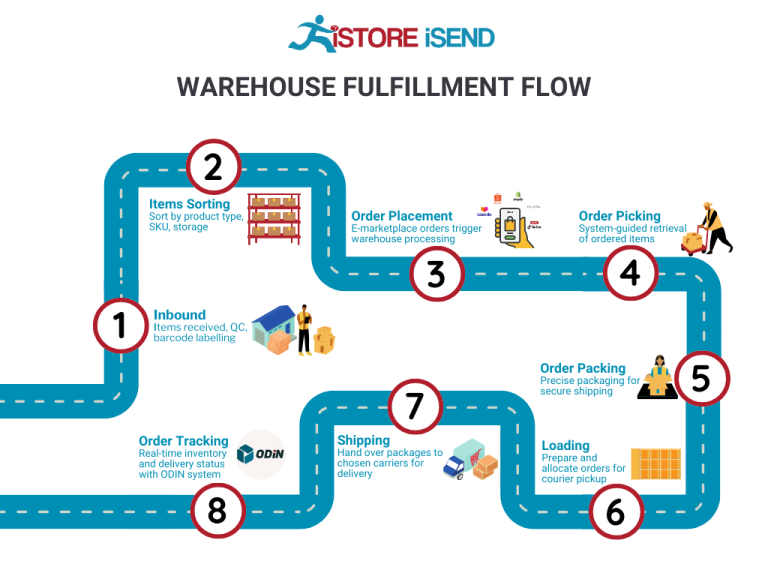
Order picking is critical for customer satisfaction, as it directly affects order accuracy and fulfillment speed. Errors in picking can lead to incorrect shipments, resulting in returns and dissatisfied customers. By streamlining this process, businesses can enhance their service levels and operational efficiency.
A key term here is batch picking, which allows workers to pick multiple orders simultaneously. This method can significantly reduce the time spent on picking by minimizing the number of trips needed throughout the warehouse.
4. Order Packing
After items are picked, they move to the order packing stage. This step involves securely packaging the selected items for shipment. Proper packing not only protects products during transit but also enhances the unboxing experience for customers. Packaging materials like boxes, bubble wrap, and packing peanuts are commonly used to ensure items are safe and secure.
The significance of order packing lies in its impact on shipping costs and customer satisfaction. Efficient packing can minimize shipping costs by reducing package size and weight, while also ensuring that items arrive undamaged, which is vital for maintaining a positive brand reputation.
A key term in this stage is dimensional weight pricing. Shipping carriers often charge based on both the actual weight and the dimensional weight of the package, which considers the size of the box. Understanding this concept can help businesses optimize their packing strategies and reduce shipping expenses.
5. Shipping & Delivery
The final step in the order fulfillment process is shipping and delivery. This involves selecting the appropriate carrier, generating shipping labels, and dispatching packages to customers. Timely shipping is crucial, as it directly affects customer satisfaction and can influence repeat purchases.
Effective shipping strategies include choosing the right shipping methods based on cost and delivery speed, as well as monitoring carrier performance. Businesses can enhance their logistics by leveraging technology such as shipping software to automate label generation and track shipments.
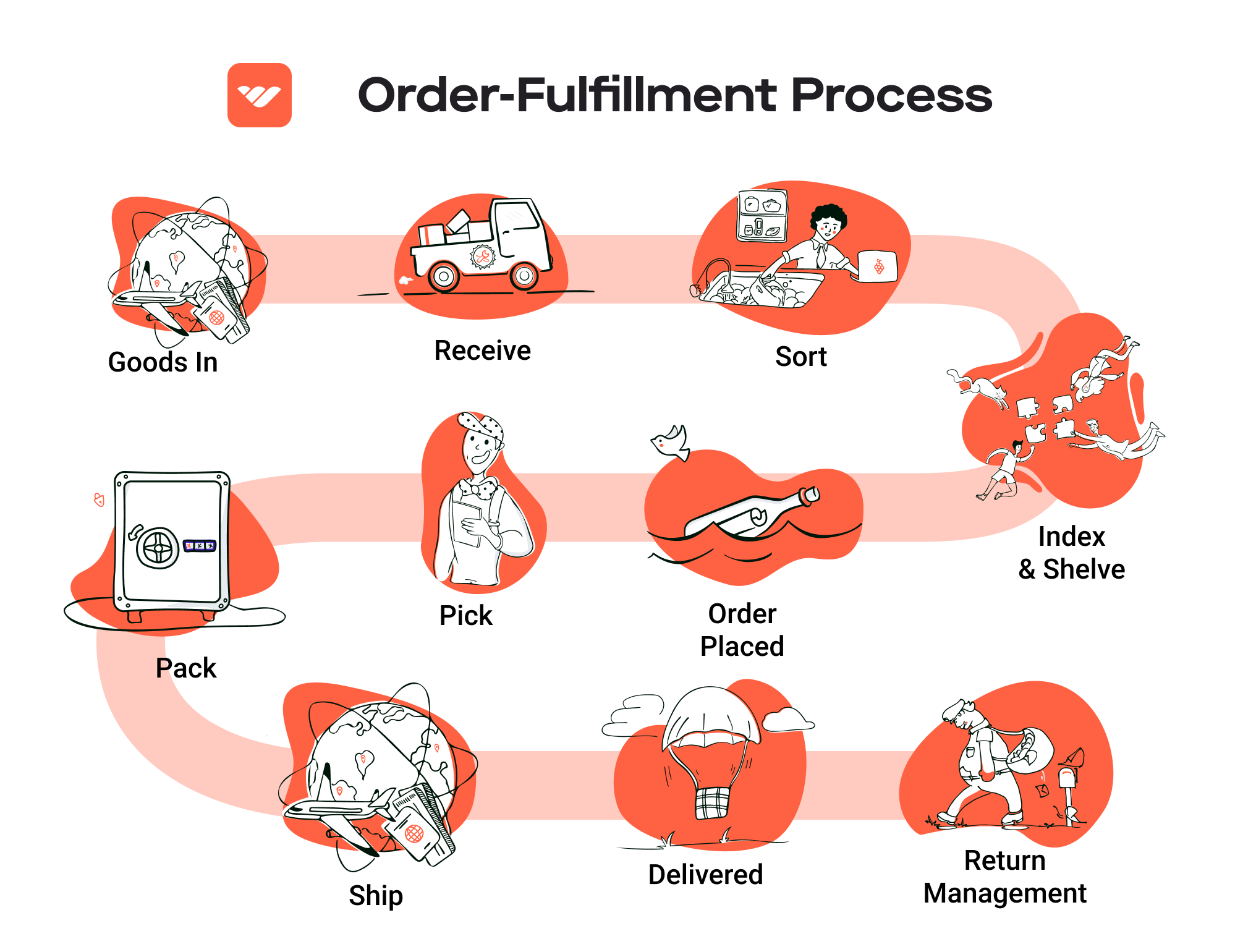
A key term associated with this step is last-mile delivery, which refers to the final leg of the shipping process where the package is delivered to the customer’s doorstep. Optimizing last-mile delivery is essential for improving customer experience and reducing shipping costs.
By understanding and optimizing each step of the order fulfillment process—from receiving inventory to shipping and delivery—e-commerce businesses can scale their operations effectively, enhance customer satisfaction, and improve overall efficiency.
Comparing Fulfillment Models: In-House vs. 3PL vs. Dropshipping
Comparison of Fulfillment Models
| Model | Who Handles Inventory | Best For (Business Stage) | Key Advantage | Key Disadvantage |
|---|---|---|---|---|
| In-House Fulfillment | The business itself | Established businesses | Full control over inventory and processes | High overhead costs and resource demands |
| Third-Party Logistics (3PL) | Third-party provider | Growing businesses | Scalability and flexibility | Less control over logistics and inventory |
| Dropshipping | Supplier | Startups or niche markets | Low upfront investment and risk | Lower profit margins and reliance on suppliers |
In-House Fulfillment
In-house fulfillment involves managing all aspects of the storage, packing, and shipping processes within the business itself. This model is typically best suited for established businesses that have a steady order volume and can afford the overhead costs associated with maintaining a warehouse, staff, and logistics infrastructure. The primary advantage of in-house fulfillment is the complete control it offers over inventory management and the entire fulfillment process. Businesses can customize their operations to meet specific customer needs, ensure quality control, and respond quickly to changes in demand. However, this model also comes with significant disadvantages, such as high overhead costs, including rent, utilities, and labor. Additionally, managing logistics can be resource-intensive, requiring substantial investment in technology and personnel, which may not be feasible for smaller or newer businesses.
Third-Party Logistics (3PL)
Third-party logistics (3PL) providers offer a comprehensive solution for businesses looking to outsource their fulfillment operations. This model is ideal for growing businesses that may not yet have the resources to handle fulfillment in-house but want to scale quickly. By partnering with a 3PL, businesses can benefit from the provider’s expertise, technology, and established logistics networks. Key advantages include improved scalability and flexibility, allowing businesses to adjust their logistics operations based on seasonal demand or growth without significant capital investment. However, relying on a 3PL can mean less control over inventory management and fulfillment processes, which can lead to discrepancies in order accuracy and customer service if the provider does not meet expectations. Therefore, it’s critical for businesses to carefully select a reputable 3PL that aligns with their operational needs and customer service standards.
Dropshipping
Dropshipping is a fulfillment model where the retailer does not hold any inventory but instead relies on suppliers to ship products directly to customers. This model is particularly advantageous for startups or businesses operating in niche markets, as it requires very little upfront investment and reduces financial risk. Entrepreneurs can offer a wide variety of products without the burden of managing inventory, which allows for rapid market entry and flexibility in product offerings. However, dropshipping also presents notable challenges, including lower profit margins due to reliance on suppliers and the risk of stockouts or shipping delays, which can negatively impact customer satisfaction. Additionally, since retailers have little control over the fulfillment process, any issues with the supplier can directly affect the retailer’s reputation. As a result, businesses must conduct thorough research to find reliable suppliers and carefully manage customer expectations regarding delivery times and product availability.
In conclusion, selecting the right fulfillment model is crucial for scaling your e-commerce operations effectively. Each model—whether in-house fulfillment, 3PL, or dropshipping—has its unique advantages and challenges, and the choice largely depends on your business stage, operational capacity, and long-term growth strategy. Understanding these factors will empower you to make informed decisions that align with your business goals and customer needs.
A Deep Dive into Amazon FBA: Pros, Cons, and Who It’s For
What is Fulfillment by Amazon (FBA)?
Fulfillment by Amazon (FBA) is a service offered by Amazon that allows e-commerce businesses to store their products in Amazon’s fulfillment centers. Amazon takes care of storage, packaging, and shipping of these products to customers. Additionally, Amazon handles customer service and returns for FBA items. This service is particularly beneficial for sellers looking to scale their operations without the burden of logistics management.
When a customer orders a product listed as FBA, Amazon’s advanced logistics network springs into action. The product is retrieved from the fulfillment center, packed, and shipped directly to the customer, often with the option for same-day or next-day delivery. This level of efficiency is made possible by Amazon’s extensive infrastructure, which includes over 1,300 fulfillment centers globally, such as the ACY1 center in West Deptford, New Jersey, which features advanced robotic systems to enhance operational efficiency.
How Does FBA Work?
-
Setup: Sellers begin by creating an Amazon seller account and enrolling in the FBA program. They then prepare their products according to Amazon’s guidelines.
-
Shipping Inventory: Sellers ship their products to Amazon’s fulfillment centers. Amazon provides guidelines on how to package and label items for shipment.
-
Storage: Once received, the products are stored in Amazon’s warehouses until sold. Sellers can track their inventory through the Amazon Seller Central dashboard.
-
Order Fulfillment: When an order is placed, Amazon picks, packs, and ships the product directly to the customer. The seller is notified of the sale, and the product is deducted from their inventory.
-
Customer Service and Returns: Amazon handles all customer service inquiries related to FBA products, including returns and refunds, providing a seamless experience for both sellers and customers.
Pros of Using FBA
1. Prime Eligibility
Products fulfilled by Amazon are automatically eligible for Amazon Prime, which can significantly increase visibility and sales. Prime members tend to prefer products that offer fast and free shipping, making FBA an attractive option for sellers looking to tap into this customer base.
2. Customer Trust
Amazon is a trusted brand globally, and using FBA can enhance a seller’s credibility. Customers often feel more secure purchasing products that are backed by Amazon’s customer service and return policies.
3. Multi-Channel Fulfillment
FBA allows sellers to fulfill orders from other sales channels (such as eBay, Shopify, or their own websites) using Amazon’s logistics. This multi-channel fulfillment capability can simplify operations for sellers with diverse sales strategies.
4. Scalability
FBA provides a scalable solution for growing businesses. Sellers can increase their inventory without worrying about storage or fulfillment logistics, allowing them to focus on other aspects of their business.
5. Advanced Logistics
Amazon’s vast network and sophisticated technology ensure that products are shipped efficiently, reducing delivery times and improving customer satisfaction.
Cons of Using FBA
1. High Fees
While FBA offers numerous advantages, it also comes with costs. Sellers are required to pay for storage fees, fulfillment fees, and additional costs for returns. These fees can eat into profit margins, especially for lower-priced items.
2. Strict Inventory Rules
Amazon has specific guidelines regarding inventory management, including limits on the number of units that can be stored in their warehouses. Sellers must stay compliant with these rules to avoid penalties or removal of their products from the platform.
3. Commingling Risks
When using FBA, products may be commingled with those from other sellers. This means that if a customer returns a defective item, it may be mixed with your inventory, posing risks to quality control and brand reputation.
4. Dependency on Amazon
Sellers become reliant on Amazon’s platform and policies, which can change unexpectedly. This dependency can be risky, especially if a seller’s business model relies heavily on FBA.
5. Limited Control over Branding
FBA requires sellers to adhere to Amazon’s branding and packaging standards, which can limit opportunities for brand differentiation. Sellers may find it challenging to establish a unique brand identity when using Amazon’s fulfillment services.
Who is FBA Best For?
Fulfillment by Amazon is ideal for a variety of sellers, particularly:
- Small to Medium-Sized Businesses: Companies looking to scale quickly without the overhead of managing their own logistics.
- E-commerce Entrepreneurs: Individuals who want to leverage Amazon’s vast customer base and infrastructure while focusing on product development and marketing.
- Seasonal Sellers: Businesses that experience fluctuating demand, such as holiday-related products, can benefit from FBA’s scalability without long-term commitments to warehousing.
- Brands Expanding Online: Established brands looking to enter the e-commerce space can use FBA to capitalize on Amazon’s infrastructure and customer trust.
- Multi-Channel Retailers: Sellers who operate across various platforms can streamline their logistics through FBA while still reaching customers through other channels.
In conclusion, FBA offers a powerful solution for e-commerce businesses aiming to streamline their operations and enhance their market reach. However, understanding the associated costs and operational complexities is crucial for making an informed decision. As with any business strategy, careful planning and consideration will help ensure that FBA aligns with your business goals and growth trajectory.
Core Services Offered by Fulfillment Centers
Inventory Management & Warehousing
Inventory management and warehousing are foundational services provided by fulfillment centers, enabling e-commerce businesses to efficiently store and manage their products. This service involves the systematic tracking of inventory levels, orders, sales, and deliveries, ensuring that businesses have the right amount of stock available at all times.
The benefits of effective inventory management are manifold:
-
Reduced Holding Costs: By optimizing inventory levels, businesses can minimize the costs associated with storing excess stock, which can include rent, utilities, and insurance.
-
Improved Cash Flow: Efficient inventory management allows businesses to free up capital that would otherwise be tied up in unsold products, enabling reinvestment into other critical areas such as marketing or product development.
-
Enhanced Customer Satisfaction: With accurate inventory tracking, businesses can ensure product availability, reducing the risk of stockouts and backorders, which can lead to lost sales and dissatisfied customers.
-
Data-Driven Decisions: Fulfillment centers typically provide detailed reporting and analytics on inventory performance, helping businesses make informed decisions about purchasing and stock levels based on trends and sales data.
Pick and Pack Services
Pick and pack services are crucial in the fulfillment process, involving the selection (picking) of products from warehouse shelves and the preparation (packing) of those items for shipment. This service is particularly vital for e-commerce businesses that require timely and accurate order fulfillment.
Key benefits of pick and pack services include:
-
Speed and Efficiency: Fulfillment centers utilize advanced technologies, such as automated picking systems and conveyor belts, to streamline the picking process. This speed is essential during peak shopping seasons when demand surges.
-
Accuracy: By implementing barcode scanning and other verification methods, fulfillment centers can significantly reduce errors in order fulfillment, ensuring that customers receive the correct items.
-
Customization Options: Many fulfillment centers offer customizable packing options, allowing businesses to create unique unboxing experiences for their customers. This can enhance brand loyalty and encourage repeat purchases.
-
Scalability: As businesses grow, fulfillment centers can easily scale their pick and pack services to accommodate increased order volumes without the need for businesses to invest in additional infrastructure.
Kitting and Assembly
Kitting and assembly services involve combining multiple products into a single package or assembling items before shipping. This service is particularly valuable for businesses that offer product bundles, promotional packages, or complex items that require assembly before they can be sold.
The advantages of kitting and assembly services include:
-
Streamlined Operations: By outsourcing kitting and assembly, businesses can save time and labor costs that would otherwise be spent on these processes in-house.
-
Enhanced Product Offerings: Kitting allows businesses to create unique product combinations that can attract more customers and increase average order values.
-
Quality Control: Fulfillment centers often have dedicated teams for kitting and assembly, ensuring that products are assembled correctly and meet quality standards before they reach the customer.
-
Reduced Shipping Costs: By bundling products together, businesses can often reduce shipping costs, as multiple items can be sent in a single package rather than individually.
Returns Management (Reverse Logistics)
Returns management, also known as reverse logistics, is the process of handling product returns from customers. This service is increasingly important in e-commerce, where return rates can be significantly higher than in traditional retail.
Benefits of efficient returns management include:
-
Customer Retention: A streamlined returns process can enhance customer satisfaction, encouraging repeat business. Customers are more likely to purchase if they know they can easily return items that do not meet their expectations.
-
Inventory Recovery: Effective returns management enables businesses to quickly process returned items, determine their condition, and reintegrate them into inventory when possible. This minimizes losses and maximizes the value of returned goods.
-
Data Insights: Analyzing return data can provide valuable insights into product performance, customer preferences, and areas for improvement in product descriptions or quality, helping businesses refine their offerings.
-
Cost Efficiency: Fulfillment centers often have established processes for handling returns, which can be more efficient than managing returns in-house. This can lead to reduced labor costs and quicker turnaround times for processing returns.
In conclusion, the core services offered by fulfillment centers—inventory management and warehousing, pick and pack services, kitting and assembly, and returns management—are essential for e-commerce businesses looking to scale. By leveraging these services, businesses can enhance operational efficiency, improve customer satisfaction, and ultimately drive growth in a competitive marketplace.
How to Choose a Fulfillment Partner: A 6-Point Checklist
Location & Warehouse Network
The geographical location of a fulfillment center is critical for optimizing shipping times and costs. A partner with warehouses strategically placed near your target markets can significantly reduce delivery times and enhance customer satisfaction.
Questions to Ask:
– Where are your warehouses located, and how do those locations align with my primary customer base?
– What is your average shipping time to key regions?
– Can you accommodate international shipping if my business expands?
Technology & Integrations
In today’s digital landscape, robust technology solutions are essential for seamless operations. A fulfillment partner should offer advanced systems that integrate smoothly with your e-commerce platform, inventory management software, and other essential tools.
Questions to Ask:
– What technology do you use for inventory management and order processing?
– Can your systems integrate with my existing e-commerce platforms (e.g., Shopify, WooCommerce, Amazon)?
– Do you offer real-time tracking and reporting capabilities for orders and inventory?
Specializations (e.g., cold storage, oversized items)
If your products have specific storage or handling requirements, it’s vital to choose a fulfillment partner with the necessary specializations. For example, businesses dealing with perishables will need cold storage facilities, while those selling large or heavy items may require specialized handling equipment.
Questions to Ask:
– What specializations do you offer that align with my product types?
– How do you handle products that require specific storage conditions (temperature, humidity, etc.)?
– Do you have experience with handling oversized or fragile items, and what processes do you have in place for these products?
Scalability & Capacity
As your business grows, your fulfillment partner must be able to scale operations accordingly. A partner with limited capacity may struggle to meet increasing demand, leading to delayed shipments and unhappy customers.
Questions to Ask:
– How do you handle peak seasons or sudden spikes in order volume?
– What is your current capacity, and how quickly can you scale to accommodate my growth?
– Can you provide examples of how you have supported other clients during rapid growth phases?
Pricing and Contracts
Understanding the pricing structure and contract terms is crucial to avoid unexpected costs that can erode your profit margins. Look for transparency in pricing and flexibility in contracts that align with your business goals.
Questions to Ask:
– What is your pricing model (per order, flat rate, volume-based)?
– Are there any additional fees I should be aware of (e.g., storage, pick and pack, returns)?
– What are the contract terms, and is there flexibility for adjustments as my business needs evolve?
Customer Support & Reviews
A reliable fulfillment partner should offer excellent customer support to address any issues promptly. Additionally, checking reviews and references can provide insight into their reputation and service quality.
Questions to Ask:
– What customer support options do you provide (phone, email, chat), and what are your hours of operation?
– How quickly do you typically respond to inquiries or issues?
– Can you provide references or testimonials from other clients, particularly those in my industry?
Choosing the right fulfillment partner is a critical decision that can impact your business’s efficiency and customer satisfaction. By using this checklist, you can make an informed choice that aligns with your operational needs and growth aspirations.
Understanding Fulfillment Pricing: A Breakdown of Common Fees
Initial Setup Fees
Initial setup fees are often incurred when you first partner with a fulfillment center like ACY1. These fees cover the administrative costs associated with onboarding your business, including the integration of your inventory management system with the fulfillment center’s systems.
Typically, the setup fee may vary based on the complexity of your operations and the technology required for integration. For example, a basic setup might cost a few hundred dollars, while more complex setups involving custom software or additional training can run into the thousands.
How It’s Calculated:
– Fixed Fee: A standard charge for all new clients.
– Variable Fee: Additional costs based on the complexity and specific needs of your business.
Receiving Fees
Receiving fees are charged when your inventory arrives at the fulfillment center. This fee covers the labor and equipment costs necessary to unload, inspect, and store your products. Receiving fees can vary based on the size and volume of your shipments.
How It’s Calculated:
– Per Unit Fee: Charged per item received.
– Hourly Rate: If the receiving process requires significant labor, an hourly rate may apply.
Storage Fees (per pallet/bin)
Storage fees are a recurring cost associated with keeping your products in the fulfillment center. These fees are typically charged on a monthly basis and are based on the amount of space your inventory occupies, measured either by pallet or bin.
How It’s Calculated:
– Per Pallet: A fixed monthly fee for each pallet stored.
– Per Bin: A fee based on the number of bins your products occupy. This may be more common for smaller or irregularly shaped items.
Storage fees can fluctuate based on demand, especially during peak seasons when space may be at a premium.
Pick & Pack Fees (per item/order)
Pick and pack fees cover the cost of selecting items from storage and packaging them for shipment. This is one of the most significant costs in the fulfillment process, as it involves both labor and materials.
How It’s Calculated:
– Per Item Fee: A charge for each item picked and packed.
– Per Order Fee: A flat fee for each order processed, regardless of the number of items.
Some fulfillment centers offer tiered pricing, where the cost per item decreases as order volume increases, making it beneficial for high-volume businesses.
Shipping Fees
Shipping fees are charged to send your products to customers. This cost can vary widely depending on the shipping method chosen, the destination, and the weight and dimensions of the package.
How It’s Calculated:
– Carrier Rates: Based on the shipping carrier (e.g., UPS, FedEx) and their respective pricing models.
– Dimensional Weight Pricing: Charges based on the size of the package rather than just its weight, which can significantly impact costs for larger items.
Tips for Getting an Accurate Quote
-
Understand Your Needs: Clearly define your inventory turnover rates, the size and weight of your products, and your expected order volume. This information is crucial for getting a tailored quote.
-
Request a Detailed Breakdown: When soliciting quotes, ask for a detailed breakdown of all potential fees. This should include initial setup, receiving, storage, pick & pack, and shipping fees.
-
Consider Seasonal Variations: Be aware that fees may change during peak seasons. Ask how the fulfillment center adjusts pricing during busy times.
-
Negotiate Terms: Don’t hesitate to negotiate terms. Many fulfillment centers are open to adjusting fees based on your projected volume or offering discounts for long-term contracts.
-
Seek Recommendations: Consult with other e-commerce businesses to understand common practices and fees in the industry. This can give you leverage when discussing terms with potential fulfillment partners.
By understanding these common fees and how they’re calculated, you can make informed decisions that align with your business goals while optimizing your fulfillment strategy.
Frequently Asked Questions (FAQs) about Fulfillment
1. What is the ACY1 Amazon Fulfillment Center?
The ACY1 Amazon Fulfillment Center, located in West Deptford, New Jersey, is a state-of-the-art facility that opened in September 2018. It spans 655,000 square feet and incorporates advanced robotics to enhance operational efficiency. The center is designed to streamline the process of receiving, storing, packing, and shipping products to customers, utilizing an extensive network of conveyor belts and robotic systems.
2. How does the ACY1 Fulfillment Center utilize robotics?
The ACY1 facility employs 300-pound robots that can carry up to 1,300 pounds each. These robots assist in locating and delivering inventory from high shelves to packing stations, significantly reducing the time and labor required for order fulfillment. This technology not only increases efficiency but also allows employees to focus on more complex tasks, thereby improving overall productivity.
3. What types of products can be fulfilled at ACY1?
The ACY1 Fulfillment Center handles a diverse range of products, including household essentials, luxury items, electronics, and more. This variety enables Amazon to meet customer demands across multiple categories, ensuring that a wide selection of items is readily available for quick delivery.
4. What is the difference between a warehouse and a fulfillment center?
A warehouse primarily serves as a storage space for products, focusing on inventory management and bulk storage. In contrast, a fulfillment center is designed to process orders and ship products directly to customers. Fulfillment centers are equipped with advanced logistics and technology to handle packing, shipping, and returns efficiently, making them integral to e-commerce operations.
5. What is a Third-Party Logistics Provider (3PL)?
A Third-Party Logistics Provider (3PL) is a company that offers outsourced logistics services, including warehousing, fulfillment, transportation, and distribution. Businesses often partner with 3PLs to streamline their supply chain operations, reduce costs, and enhance their ability to scale. The ACY1 center can serve as a 3PL for sellers utilizing Amazon’s Fulfillment by Amazon (FBA) program.
6. How much do fulfillment services cost?
The cost of fulfillment services varies based on several factors, including order volume, storage space, and specific services utilized (e.g., packaging, shipping methods). For businesses using the ACY1 center, fees typically encompass storage costs per cubic foot, handling fees per order, and shipping costs based on weight and destination. It’s advisable to consult with Amazon or a logistics expert to get a tailored quote based on your business needs.
7. How does ACY1 ensure order accuracy and efficiency?
The ACY1 Fulfillment Center employs advanced technology, including barcode scanning and automated systems, to ensure high levels of order accuracy. Additionally, the integration of robotics and conveyor systems minimizes manual errors, enabling faster processing times. Continuous training programs for employees also contribute to maintaining quality standards.
8. What are the peak operational times for the ACY1 center?
The ACY1 center typically experiences peak operational times during the holiday season, especially from November to January, when demand for online shopping surges. Additionally, special sales events such as Prime Day and Black Friday can also lead to increased activity. Businesses are encouraged to plan their inventory and fulfillment strategies accordingly during these periods.
9. Can small businesses use the ACY1 Fulfillment Center?
Yes, small businesses can utilize the ACY1 Fulfillment Center by enrolling in Amazon’s Fulfillment by Amazon (FBA) program. This program allows sellers to store their products at Amazon fulfillment centers, where Amazon takes care of storage, packing, and shipping, thus enabling small businesses to leverage Amazon’s extensive logistics network.
10. What support does Amazon provide to employees at ACY1?
Amazon is committed to employee development at the ACY1 Fulfillment Center by offering on-site classrooms for continuing education programs. This initiative helps employees acquire new skills and advance their careers within the company. Additionally, Amazon promotes a culture of community involvement through charitable donations and partnerships with local organizations, enhancing employee engagement and corporate responsibility.
Conclusion: Is Outsourcing Fulfillment the Right Move for Your Business?
Evaluating the Benefits of Outsourcing Fulfillment
Outsourcing fulfillment can be a transformative decision for e-commerce businesses aiming to scale operations efficiently. By leveraging a fulfillment service, you can save significant time and resources. Instead of managing inventory, packing, and shipping in-house, your team can focus on core business activities such as marketing, product development, and customer engagement. This strategic shift not only enhances productivity but also allows for a more agile response to market demands.
Scalability is another critical advantage. As your business grows, so do the complexities of order fulfillment. A dedicated fulfillment partner can provide the necessary infrastructure and technology, enabling you to handle increased order volumes without the headache of expanding your physical space or workforce. For instance, fulfillment centers like ACY1 in New Jersey utilize advanced robotics and extensive conveyor systems, which streamline operations and ensure timely deliveries—a vital component of customer satisfaction.
Moreover, these partners bring specialized expertise in logistics, compliance, and inventory management. They are equipped with the latest technology to optimize shipping routes, reduce costs, and enhance the overall customer experience. This expertise can be particularly beneficial during peak seasons, where demand surges can overwhelm in-house capabilities.
However, the effectiveness of outsourcing hinges on selecting the right partner. Conduct thorough research and consider factors such as their operational capabilities, technology stack, and customer service track record. A misaligned partner can hinder your growth rather than facilitate it.
Next Steps
As you contemplate whether outsourcing fulfillment is right for your business, take the time to audit your current shipping processes. Assess whether your existing operations can meet future demands or if a fulfillment partner could provide the necessary support for your growth ambitions. This strategic evaluation could be the key to unlocking new levels of efficiency and customer satisfaction in your e-commerce journey.
Important Disclaimer
⚠️ Important Disclaimer
The information in this guide is for educational purposes. Fulfillment services, pricing, and platform features change frequently. Always conduct your own due diligence and consult with providers directly before making business decisions.
